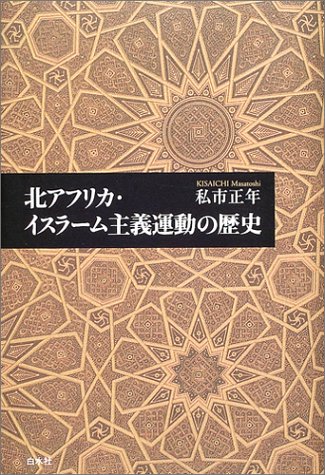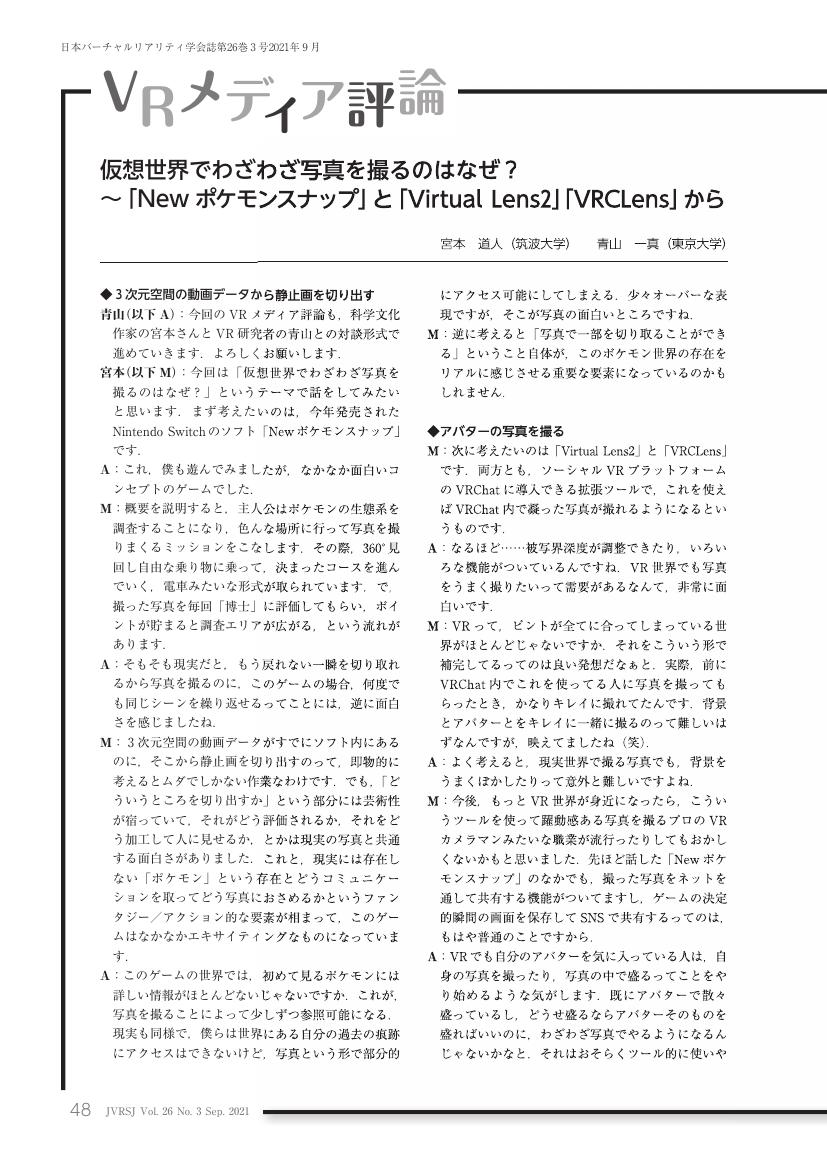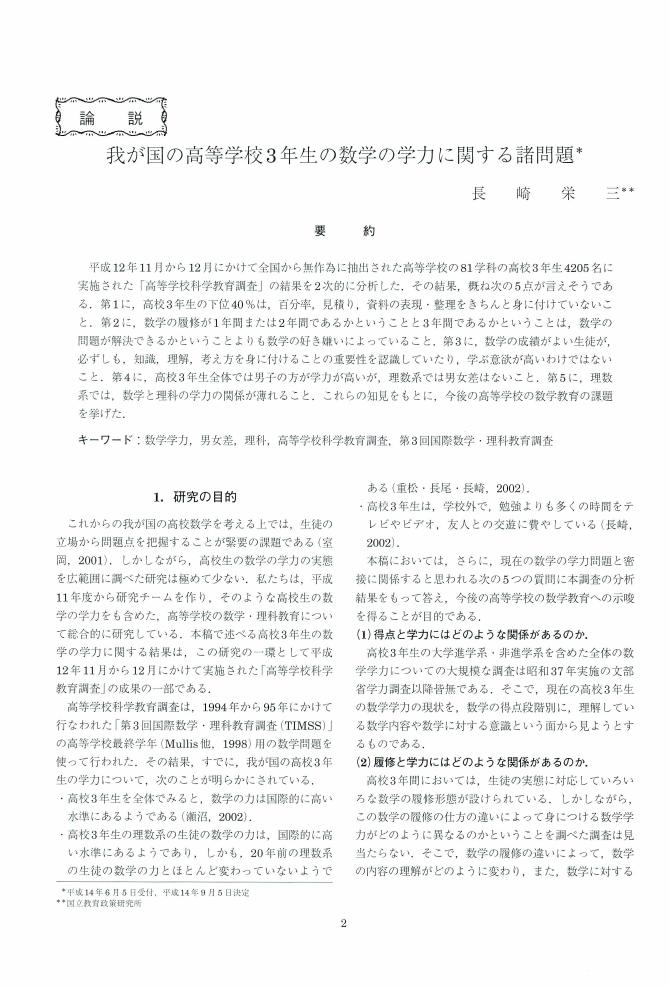- 著者
- 小倉 秀夫
- 出版者
- 有斐閣
- 雑誌
- 論究ジュリスト = Quarterly jurist (ISSN:21871302)
- 巻号頁・発行日
- no.12, pp.238-242, 2015
5 0 0 0 IR 「家」の人類学的研究--レヴィ=ストロースからブルデューへ
- 著者
- 小池 誠 Makoto Koike
- 出版者
- 桃山学院大学総合研究所
- 雑誌
- 国際文化論集 (ISSN:09170219)
- 巻号頁・発行日
- no.29, pp.237-264, 2003-12
The aim of this paper is to examine the concept of 'house' and 'house societies' whose definition and description was introduced by Claude Levi-Strauss. The concept of the house as a social group was elaborated by him while anthropologists were concerned with the material and symbolic aspects of houses. Levi-Strauss defined the house as 'a moral person' which perpetuates itself through the transmission of its name, its goods, and its titles down a real or imaginary line. I try to review the writings inspired by his ideas on the house, which are problematic and left nagging questions unresolved. He concluded that the house is not a social group delimited by rules of descent or residence. The less rulebound aspect of the house requires the concept of 'strategy' proposed by Bourdieu. The members of a house employ strategies aimed at its perpetuation against the backdrop of collective constraints.
5 0 0 0 OA 青森県名鑑 : 大正四年特別大演習記念
- 著者
- 高谷繁太郎, 江馬英三郎 編
- 出版者
- 青森県行幸記念協会
- 巻号頁・発行日
- 1917
5 0 0 0 OA ジャン=リュック・ナンシーの身体論 : 『コルプス』読解を中心に
- 著者
- 柿並 良佑
- 出版者
- 立命館大学国際言語文化研究所
- 雑誌
- 立命館言語文化研究 = 立命館言語文化研究 (ISSN:09157816)
- 巻号頁・発行日
- vol.26, no.3, pp.91-105, 2015-02
5 0 0 0 OA 陸軍諸学校入学試験問題及模範解答集
5 0 0 0 北アフリカ・イスラーム主義運動の歴史
- 著者
- Keita MITOMI Mayu AKAKI Nobuyuki KOBAYASHI Kenichi TAKANO
- 出版者
- Japanese Society for the Science of Design
- 雑誌
- Journal of the Science of Design (ISSN:24242217)
- 巻号頁・発行日
- vol.5, no.2, pp.2_91-2_100, 2021-11-30 (Released:2021-12-09)
- 参考文献数
- 22
In order to encourage the understanding of values and wide use of prototyping (PT), there are previous studies which indicate the classification of PT. While PT is essential to the development of products and solutions, novice designers can only select PT from a narrow understanding and recognition of it. Therefore, it is difficult for them to decide which kind of PT to create and they might select an ineffective one.In this paper, we divided the 74 implemented PT into groups according to the novice designer's depth of understanding of values that derived solutions have. PTs were implemented by novice designers at an example project, such as the Design Project (D-Pro) at a graduate school. Based on a review of submitted materials and interviews, implemented PTs were divided into three groups, namely "Exploratory PT", "Externalize PT", and "Needs Confirmatory PT". Through interviews with novice designers, we indicate that the proposed classification supports them to select an effective PT.In addition, by comparing the result of the performed PT when the classification is exhibited to the novice designers or not, we indicate that the ratio of PT in the earlier phase increases, and the average number of total PT slightly increases by exhibiting the classification.
- 著者
- 宮本 道人 青山 一真
- 出版者
- 特定非営利活動法人 日本バーチャルリアリティ学会
- 雑誌
- 日本バーチャルリアリティ学会誌 (ISSN:13426680)
- 巻号頁・発行日
- vol.26, no.3, pp.48-49, 2021-09-30 (Released:2021-11-05)
5 0 0 0 OA 一中学校教員からみた小学校算数教育の課題
- 著者
- 丹 洋一
- 出版者
- 一般社団法人 数学教育学会
- 雑誌
- 数学教育学会誌 (ISSN:13497332)
- 巻号頁・発行日
- vol.58, no.1-2, pp.29-37, 2017 (Released:2020-04-21)
中学生に対しての数学指導の経験と中学生へのアンケート調査を踏まえて,小学校算数教育における課題と中学校での学習の基本となる必要な経験についても検討する。その上で今後の小学校段階での算数指導において,論理的思考力の育成・Excel 等を用いた代数概念の養成・製作活動を通じた図形概念の育成・学習ツールとしてのICT利用を進めることの重要性を論じる。
5 0 0 0 OA 精神病理ネットワークの応用可能性
- 著者
- 樫原 潤
- 出版者
- JAPANESE PSYCHOLOGICAL REVIEW
- 雑誌
- 心理学評論 (ISSN:03861058)
- 巻号頁・発行日
- vol.62, no.2, pp.143-165, 2019 (Released:2020-12-20)
- 参考文献数
- 106
- 被引用文献数
- 1
Depression is one of the most burdensome mental disorders, and effective treatments for depression are needed. This review highlights that the network perspectives of psychopathology can promote tailored therapies for depression and improve the quality of treatment. First, we discuss that depression heterogeneity can be depicted by quantitative data analyses. Second, we review two previous clustering approaches that have been utilized to develop tailored therapy for depression: the first is based on a staging model and the second focuses on depression subtypes. Third, we focus on models and analyses of psychopathology networks, which have recently received substantial attention in clinical psychology. We demonstrate that psychopathology network models view mental disorders as complex interplays of symptoms, and we introduce analytic procedures and previous studies based on these models. We then summarize differences and similarities between network and clustering approaches and discuss how psychopathology networks can further promote tailored therapies for depression. Finally, we discuss the requirements for the practical use of psychopathology networks from the perspectives of cost-effectiveness and collaboration of data scientists and clinicians.
5 0 0 0 OA 天文暦法と陰陽五行説
5 0 0 0 OA 我が国の高等学校3年生の数学の学力に関する諸問題
- 著者
- 長崎 栄三
- 出版者
- 公益社団法人 日本数学教育学会
- 雑誌
- 日本数学教育学会誌 (ISSN:0021471X)
- 巻号頁・発行日
- vol.85, no.3, pp.2, 2003 (Released:2021-04-01)
- 出版者
- 日経BP社
- 雑誌
- 日経コンピュ-タ (ISSN:02854619)
- 巻号頁・発行日
- no.577, pp.48-51, 2003-06-30
仕事納めを翌日に控えた昨年12月26日の午後7時、福島県岩代町いわしろまち役場にSIベンダーのエフコムから緊急の連絡が入った。同日の午後に同社が預かった、全町民約9600人の個人データが入ったDAT5本が盗まれたというのだ。福島市内の駐車場で車上荒らしに遭ったのである(図1)。
5 0 0 0 OA 明治大学五十年史
- 著者
- 明治大学学報発行所 編
- 出版者
- 明治大学学報発行所
- 巻号頁・発行日
- 1931
5 0 0 0 OA 新型コロナウイルス感染症(COVID-19)とタバコ
- 著者
- 松崎 道幸
- 出版者
- 特定非営利活動法人 日本禁煙学会
- 雑誌
- 日本禁煙学会雑誌 (ISSN:18826806)
- 巻号頁・発行日
- vol.15, no.2, pp.29-31, 2020-07-01 (Released:2020-07-31)
- 参考文献数
- 11
5 0 0 0 OA 刀剣文化受容に伴う古代信仰の変化について
- 著者
- 酒井 利信
- 出版者
- 日本武道学会
- 雑誌
- 武道学研究 (ISSN:02879700)
- 巻号頁・発行日
- vol.31, no.2, pp.40-54, 1998-12-30 (Released:2012-11-27)
- 参考文献数
- 52
In ancient Japan, the concept of gods had been changed as passing of time. From this fact, it is expected that Japanese primitive faith had been changed, as sword culture was transmitted from China. In this paper, we describe transformation of primitive belief and foundation of unique Japanese sword culture, in the process of accepting sword culture.The summary is as follows:1. Sword culture influenced ancient Japanese mental world, and changed belief in the fire. This belief in the fire changed from destructive to constructive and part of this had been absorbed in the concept of sword.2. Originally, ancient people believed in god of snake that supported farming. But, as the time went by, power of god of snake had declined, and this faith was absorbed in the concept of the sword.3. Power of god of thunder had decline, too. The belief in this had concentrated at peculiar god “Takemikazuchi”, and this had been related to sword.4. The sword came to absorb concepts of fire and snake. And related to “Takemikazuchi”, it was recognized as god itself.5. From the above discussion, it is assumed that there is a unique Japanese way of thinking that sword is related to god. This is thought to be a foundation of concept of sword in Japan.
5 0 0 0 愛知県常滑市における「ギャンブル空間」の形成
- 著者
- 寄藤 晶子
- 出版者
- 人文地理学会
- 雑誌
- 人文地理 (ISSN:00187216)
- 巻号頁・発行日
- vol.57, no.2, pp.131-152, 2005
- 被引用文献数
- 1
In this paper, the author argues that gambling businesses managed by public authorities face issues regarding monopolization, regulation of space and socio-spatial exclusion.Since the end of the 19th century, informal private gambling has been strictly outlawed in Japan, while both the national and local governments have resorted to investing in the gambling business to secure revenue. At present, with the exception of lotteries, 120 gambling facilities such as keiba (horse race), keirin (bicycle race on a short track), autorace (motorcycle race on a short track), and kyotei (motorboat race on a square pond) are offered by 21 prefectures and 443 municipalities. These are called "public gambling".In his book The Production of Space, Henri Lefevre notes that non-productive expenses are made according to the neocapitalist's interest. Therefore, the author refers to the three elements that constitute space according to Lefevre: spatial practices, representations of space and space of representations. The author conducted field work in and around the motorboat gambling facility operated in Tokoname City, Aichi Prefecture, and the highlighted the "gambling space" using Lefevre's scheme mentioned above.From 1997-2000, the author interviewed: Tokoname motorboat officers, residents from the areas (sinkai-cho) around the motorboat facility, police officers, members of the "koie-sinkai crime prevention association", a security guard and ticket sales women employed at the motorboat office, shop managers in and around the motorboat facility, and the motorboat gambling fans. The author also conducted participant observation studies of more than 400 motorboat gambling fans. The author's findings are as follows:Firstly, while the public authority, the Tokoname motorboat office, adopts several measures to draw visitors to the motorboat facility and thus ensure income, this practice includes spatial separation, i.e., separating the Tokoname motorboat gambling fans from the public. This is partly because the nature of gambling itself threatens social order, therefore, the public authorities control and enclose gambling fans. These practices of exclusion are observed in their spatial practices.Secondly, shops and restaurants are located on the route taken by visitors from the Tokoname railway station to the motorboat facility. These shops and restaurants sell alcohol, low-priced light meals and magazines or newspapers regarding gambling. Fans regularly take the route from the Tokoname railway station to the motorboat facility and purchase these goods from these shops. Loitering fans and torn blank tickets visibly distinguish the "gambling space" from the rest of the city. Japanese public gambling fans are largely men over 60 years of age. However, in Tokoname motorboat facility, 60-70% of motorboat gambling fans are men, who are 60 years and over. Therefore, the "gambling space" is occupied by middle and old-aged men is littered with blank tickets.Thirdly, measures adopted by the local community, the "koie-sinkai crime prevention association", neighborhood residents and the police to regulate the behavior of visitors' create negative representations of Tokoname motorboat gambling facility and its fans. In 1970, as the number of visitors increased, a few residents living around the motorboat facility founded a crime prevention association in order to put a burglar alarm to their house. At this time, the Tokoname motorboat office began sending presents, such as handkerchiefs, rice, pans and soaps as compensation to residents. The activities of "koie-sinkai crime prevention association" provided subsidies by Tokoname City, although they are not strictly monitored. They unfairly claimed and represented the undesirable behavior of visitors in order to protect their interests.
5 0 0 0 IR 日常談話における反復表現の機能に関する一考察
- 著者
- 松田 文子 MATSUDA Fumiko まつだ ふみこ
- 出版者
- お茶の水女子大学日本言語文化学研究会
- 雑誌
- 言語文化と日本語教育 (ISSN:09174206)
- 巻号頁・発行日
- vol.16, pp.58-69, 1998-12-05



